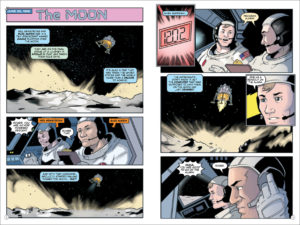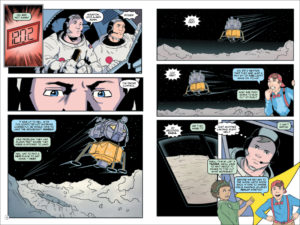Neil Armstrong will never fall out of the history books — in July 1969, the astronaut became the first human being to ever step foot on the moon. Here are some little-known facts about the man and his work, which are also the subjects of a new book from Portable Press.
- Neil Armstrong got into Purdue University at age 17, opting to attend there instead of the prestigious Massachusetts Institute of Technology. His uncle, an alum, told him that he’d get just as decent of an education at Purdue.
- To pay for college, Armstrong served as a navy pilot for three years, flying 80 combat missions in the Korean War, then joining the NASA
precursor agency, the National Advisory Committee for Aeronautics as a test pilot.
- After becoming the first person to walk on the moon in 1969, Armstrong stated, “That’s one small step for man, and one giant leap for mankind.” He came up with that grand quotation just a few minutes before he said it. However, he got it wrong — Armstrong meant to say, “That’s one small step for a man, and one giant leap for mankind” (which makes more sense).
- Armstrong didn’t get a salary bonus for walking on the moon, but he earned a NASA salary of $27,400 in 1969. Adjusted for inflation, that works out to around $172,000. As he was on the moon for just under three hours, he earned an hourly rate of $32.92 for that moonwalk.
Neil Armstrong: First Man on the Moon!
- Over the course of NASA’s many Apollo moon missions, astronauts left 96 bags of poop on the moon. Armstrong left four of those.
As there’s no breathable atmosphere on the moon, Armstrong kept his helmet on. But he collected a lot of rocks and when he smelled them when he was back safely in the Lunar Module, he found that they, and thus the moon, had an odor like that of wet ashes and gunpowder.
- After returning from the moon, Armstrong had to quarantine for three weeks… just in case he contracted a weird illness in space.
- Armstrong rarely spoke with the media during his lifetime, but in 1970 he told a reporter that he figured there’d be a permanent, manned moon base by 2000. That didn’t happen, and in 2010, he once again emerged from private life to testify before the U.S. House of Representatives’ Science and Technology Committee to advocate for NASA going back to the moon, as there remained millions of square miles of unexplored terrain up there. (That’s yet to happen, too.)
For more about this pioneer of science and space, read Show Me History: Neil Armstrong — First Man on the Moon! It’s available now from Portable Press.











 As there’s no breathable atmosphere on the moon, Armstrong kept his helmet on. But he collected a lot of rocks and when he smelled them when he was back safely in the Lunar Module, he found that they, and thus the moon, had an odor like that of wet ashes and gunpowder.
As there’s no breathable atmosphere on the moon, Armstrong kept his helmet on. But he collected a lot of rocks and when he smelled them when he was back safely in the Lunar Module, he found that they, and thus the moon, had an odor like that of wet ashes and gunpowder.